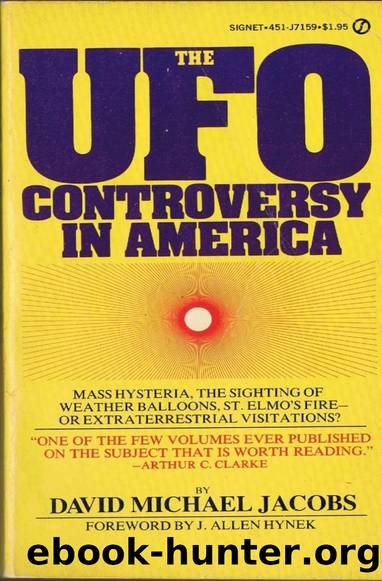The UFO Controversy In America by David M. Jacobs

Author:David M. Jacobs [Jacobs, David M.]
Language: eng
Format: epub
ISBN: 9780253190062
Goodreads: 713136
Published: 2012-03-15T07:16:24+00:00
1 64
The UFO Controversy in A merica
ports and examples of Air Force secrecy and by its letter writing campaign.115
�
The Air Forceâs public relations problems remainedâeven though the Office of Information, the Office of Legislative Liaison, and the Office of the Assistant Chief of Staff for Intelligence tried to avert congressional hearings, discredit NICAP
and Keyhoe, and transfer the UFO project. And the sighting
�
reports continued to come into A TIC at a steady rate of between 500 and 600 a year. ATIC received 474 reports in 1 962, and this was far from the desired goal of no reports at j
all. Consequently, in 1 962 ATIC made one final effort to
·,
transfer the UFO program. lis
l
,
Edward R. Trapnell, assistant for public relations to the secretary of the Air Force, had become interested in the UFO program and requested a briefing from Lieutenant Coionel Friend ( recently promoted from major) . At the briefing, Friend and Hynek told Trapnell · about the Robert-
·jâ
son panelâs recommendations and the Air Forceâs attempts to educate the public by stripping the UFO program of its âaura of mysteryâ and putting it in âits proper perspective.â Trapnell âwas amazed to learnâ that UFO reports were, as Friend and Hynek had told him, three times higher in 1 962 than the yearly totals in the 1 947 to 1 9 5 1 period, and he observed that
âthis could grow into a lifetime job unless headed off in some manner.â57
Afterward, Trapnell met with the Secretary of the Air Force Zuckert, Dr. Brockway McMillan (head of Air Force research and development) , and Dr. Robert Calkins (president of the Brookings Institution) ; they suggested several transfer plans. The Air Force could transfer the UFO program to an agency such as the National Aeronautics and Space Administration, the National Science Foundation, or the Smithsonian Institution. Or the Air Force could contract it out to a private group, such as the Brookings Institution, which would operate the program under the auspices of an Air Force scientific complex such as, for example, the Office of Aerospace Research. Or, third, the Air Force could contract the project to a private organization and not keep it under Air Force auspices. The organization could âmake positive statements regarding the program. and the Air Forceâs handling of it in the past and make recommendations regarding its future, i.e., disban[d] the program completelyâ or transfer it to NASA or the like. liS
Download
This site does not store any files on its server. We only index and link to content provided by other sites. Please contact the content providers to delete copyright contents if any and email us, we'll remove relevant links or contents immediately.
| Ancient & Controversial Knowledge | Ghosts & Hauntings |
| Hermetism & Rosicrucianism | Magic Studies |
| Occultism | Parapsychology |
| Supernatural | UFOs |
| Unexplained Mysteries |
Animal Frequency by Melissa Alvarez(4394)
Sigil Witchery by Laura Tempest Zakroff(4179)
Real Magic by Dean Radin PhD(4073)
Fingerprints of the Gods by Graham Hancock(3938)
Aleister Crowley: The Biography by Tobias Churton(3586)
Journeys Out of the Body by Robert Monroe(3567)
The Rosicrucians by Christopher McIntosh(3465)
Alchemy and Alchemists by C. J. S. Thompson(3448)
Mysteries by Colin Wilson(3394)
Hitler's Monsters by Eric Kurlander(3268)
The Hatha Yoga Pradipika (Translated) by Svatmarama(3227)
John Dee and the Empire of Angels by Jason Louv(3130)
Wicca: a guide for the solitary practitioner by Scott Cunningham(3125)
Infinite Energy Technologies by Finley Eversole(2937)
Book of Life by Deborah Harkness(2863)
Dark Star Rising by Gary Lachman(2828)
The Book of Lies by Aleister Crowley(2800)
Aliens by Jim Al-Khalili(2785)
To Light a Sacred Flame by Silver RavenWolf(2767)
